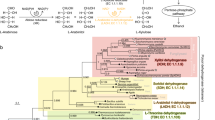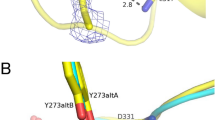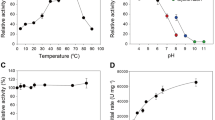Abstract
The thermostability of D-xylose isomerase from Thermoanaerobacterium thermosulfurigenes was enhanced by site-directed substitutions of aromatic amino acids in the active site. This enhancement may be explained as the consequence of the reduction of the area of water-accessible hydrophobic surface. The kinetics of thermoinactivation of the enzyme in aqueous solution was also investigated, and we report that in addition to the well known divalent cations, the monovalent cation, K+, also protects the enzyme against thermoinactivation. The kinetic data suggest that the formation of incorrect conformations of the enzyme (“scrambled structure”) is the dominant factor governing the process of thermoinactivation at elevated temperature (80–90°C).
This is a preview of subscription content, access via your institution
Access options
Subscribe to this journal
Receive 12 print issues and online access
$209.00 per year
only $17.42 per issue
Buy this article
- Purchase on Springer Link
- Instant access to full article PDF
Prices may be subject to local taxes which are calculated during checkout
Similar content being viewed by others
References
Chen, W.-P. 1980. Glucose isomerase (a review). Process Biochem. 15: 36–41.
Lee, C., Lee, C. and Zeikus, J.G. 1991. Purification and characterization of thermostable glucose isomerase from Clostridium thermosulfurogenes and Thermuanaerobacter strain B6A. Biochem. J. 274: 565–571.
Henrick, K., Collyer, C.A. and Blow, D.M. 1989. Structures of D-xylose isomerase from Anhrobacter strain B3728 containing the inhibitors xylitol and D-sorbitol at 2.5 Å and 2.3 Å resolution, respectively. J. Mol. Biol. 208: 129–157.
Collyer, C.A., Henrick, K. and Blow, D.M. 1990. Mechanism for aldose-ketose interconversion by D-xylose isomerase involving ring opening followed by a 1,2-hydride shift. J. Mol. Biol. 212: 211–235.
Carrell, H.L., Glusker, J.P., Burger, V., Manfre, F., Tritsch, D. and Biellmann, J.F. 1989. X-ray analysis of D-xylose isomerase at 1.9Å: native enzyme in complex with substrate and with a mechanism-designed inactivator. Proc. Natl. Acad. Sci. USA 86: 4440–4444.
Whitlow, M., Howard, A.J., Finzel, B.C., Poulos, T.L., Winborne, E. and Gilliland, G.L. 1991. A metal-mediated hydride shift mechanism for xylose isomerase based on the 1.6 Å Streptomyces rubiginosus with xylitol and D-xylose. Proteins 9: 153–173.
Farber, G.K., Glasfeld, A., Tiraby, G., Ringe, D. and Petsko, G.A. 1989. Crystallographic studies of the mechanism of xylose isomerase. Biochemistry 28: 7289–7297.
Jenkins, J., Janin, J., Rey, F., Chiadmi, M., van Tilbeurgh, H., Lasters, I., De Mareyer, M., Van Belle, D., Wodak, S.J., Lauwreys, M., Stanssens, P., Mrabet, N.T., Snauwaert, J., Matthyssens, G. and Lamberi, A.-M. 1992. Protein engineering of xylose (glucose) isomerase from Aainoplanes missouriensis. 1. crystallography and site-directed mutagenesis of metal binding sites. Biochemistry 31: 5449–5458.
Lee, C., Bagdasarian, M., Meng, M. and Zeikus, J.G. 1990. Catalytic mechanism of xylose (glucose) isomerase from Clostridium thermosulfurogenes. J. Biol. Chem. 265: 19082–19090.
Matsumura, M., Signor, G. and Matthews, B.W. 1989. Substantial increase of protein stability by multiple disulfide bonds. Nature 342: 291–293.
Matthews, B.W., Nicholson, H. and Becktel, W.J. 1987. enhanced protein thermostability from site-directed mutations that decrease the entropy of unfolding. Proc. Natl. Acad. Sci. USA 84: 6663–6667.
Nicholson, H., Becktel, W.J. and Matthews, B.W. 1988. Enhanced protein stability from designed mutations that interact with α-helix dipoles. Nature 336: 651–656.
Sandberg, W.S. and Terwilliger, T.C. 1989. Influence of interior packing and hydrophobicity on the stability of a protein. Science 245: 54–56.
Wigley, D.B., Clarke, A.R., Dunn, C.R., Barstow, D.A., Atkinson, T., Chia, W.N., Muirhead, H. and Holbrook, J.J. 1987. The engineering of a more thermally stable lactate dehydrogenase by reduction of the area of water-accessible hydrophobic surface. Biochim. Biophysica. Acta 916: 145–148
Quax, W.J., Mrabet, N.T., Luiten, R.G.M., Schuurhuizen, P.W., Stanssens, P. and Lasters, I. 1991. Enhancing the thermostability of glucose isomerase by protein engineering. Bio/Technology 9: 738–742.
Sanger, F., Nicklen, S. and Coulson, A.R. 1977. DNA sequencing with chain-terminating inhibitors. Proc. Natl. Acad. Sci. USA 74: 5463–5467.
Dawson, R.M.C., Elliott, D.C., Elliott, W.H. and Jones, K.M. 1986. PH, buffer, and physiological media, p. 417–448. In: Data for Biochemical Research, 3rd Ed. Clarendon Press, Oxford.
Laemmli, U.K. 1970. Cleavage of structural proteins during the assembly of the head of bacteriophage T4 . Nature 227: 680–685.
Tomazic, S.J. and Klibanov, A.M. 1988. Mechanism of irreversible thermal inactivation of Bacillus α-amylases. J. Biol. Chem. 263: 3086–3091.
Kasumi, T., Hayashi, K. and Tsumura, N. 1982. Role of cobalt in stabilizing the molecular structure of glucose isomerase from Streptomyces griseofuscus S-41. Agric. Biol. Chem. 46: 31–39.
Callens, M., Kersters-Hilderson, H., Vangrysperre, W. and De Bruyne, C.K. 1988. D-Xylose isomerase from Streptomyces violaceoruber: structural and catalytic roles of bivalent metal ions. Enzyme Microb. Technol. 10: 695–700.
Gaikwad, S.M., Rao, M.B. and Deshpande, V.V. 1992. D-Glucose/xylose isomerase from Streptomyces: differential roles of magnesium and cobalt ions. Enzyme Micro. Technol. 14: 317–320.
Rangarajan, M., Asboth, B. and Hartley, B.S. 1992. Stability of Arthrobacter D-xylose isomerase to denaturants and heat. Biochem. J. 285: 889–898.
Argos, P., Rossmann, M.G., Grau, U.M., Zuber, H., Frank, G. and Tratschin, J.D. 1979. Thermal stability and protein structure. Biochemistry 18: 5698–5703.
Lowe, S., Jain, M.K. and Zeikus, J.G. 1933. Biology, ecology and biotech-nological applications of anaerobic extremophiles adapted to environmental stress in temperature, pH, salinity or substrate. Microbiol. Reviews, In press.
Author information
Authors and Affiliations
Rights and permissions
About this article
Cite this article
Meng, M., Bagdasarian, M. & Zeikus, J. Thermal Stabilization of Xylose Isomerase from Thermoanaerobacterium thermosulfurigenes. Nat Biotechnol 11, 1157–1161 (1993). https://doi.org/10.1038/nbt1093-1157
Received:
Accepted:
Issue Date:
DOI: https://doi.org/10.1038/nbt1093-1157
This article is cited by
-
d-Xylose Isomerase from a Marine Bacterium, Vibrio sp. Strain XY-214, and d-Xylulose Production from β-1,3-Xylan
Marine Biotechnology (2012)
-
A Chromosome Integration System for Stable Gene Transfer into Thermus flavus
Nature Biotechnology (1995)



